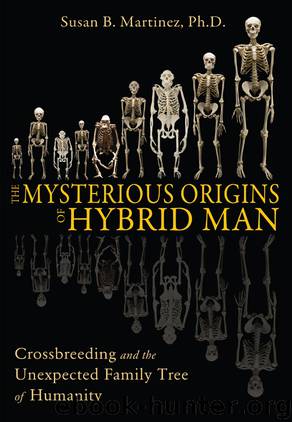Mysterious Origins of Hybrid Man by Susan B. Martinez Ph.D

Author:Susan B. Martinez, Ph.D.
Language: eng
Format: epub
Tags: Spirituality/Ancient Mysteries
Publisher: Inner Traditions / Bear & Company
Published: 2013-10-28T16:00:00+00:00
Figure 7.7. Sign of hin’ kwa (with the same root as Ihin) designating the unseen part within corpor, that is, spirit within body. Oahspe teaches, “they were called Ihins, because they were begotten of both heaven and earth.” The Ihins were the first on Earth to be endowed with soul power, an etheric, inner connection to the cosmos, the thing within a thing—that spark that gave the human race everlasting life in the hereafter.
Figure 7.8. The diagram of Hinqua is frequently seen in undeciphered petroglyphs: (A) Hinquas from Forsyth County, Georgia. (B) Cup marks similar to these have been found in England, France, Italy, Spain, Algeria, Israel, China, India, and the Gobi Desert, epigraphers sometimes inferring an otherworldly or shamanistic meaning.
When the Holy Bible speaks of Enoch walking with God and not seeing death (Genesis 5:23, 24, Hebrews 11:5), this also is a metaphor of immortality, conferred by the caste of patriarchs, all with Ihin blood, not unlike Indra, the Hindu “god” who bestowed immortality. The little sacred people came to be worshipped among the barbarians, to whom they appeared as very gods. Thus do we find dwarfs sacred to the sun god in Peru, just as the Mexicans and also the Egyptians had their dwarf gods (Ptah and Bes, in Egypt).
Among the Cherokee, the little people who were called Nunnehi are remembered as “the immortals.” In Europe as well, it was the pintsized Tuatha De Danaan (people of light, heroes of the old Irish) who had all the powers of the immortals, for they and their forebears were the first men on Earth to attain everlasting life. This is the reason that “fairy” land (abode of the Ihins) was remembered in myth as pleasurable and without death and the reason that the fairies themselves were called the Ageless Ones, the elves who “lived a thousand years.”
We have seen that the chosen (Ihin) were commanded to marry among themselves only and to withdraw from other peoples: “The Ihins shall not mingle with any other people on the face of the earth.”30 This commandment goes all the way back to the beginning: in the best known story of Adam and Eve, the pair was driven from the Garden of Eden for disobedience. What was that disobedience?—giving in to forbidden marriage, crossbreeding. “Death” through Adam’s sin actually stands for loss of immortality through back breeding—a spiritual death. The same marriage rule (endogamy), in a latterday context, appears in Genesis 28:1: “You shall not take a wife from the daughters of Canaan” (that is, descendants of Cain). And in Ezra 9:1–2: “The people of Israel,” complained the Old Testament, “have not separated themselves from the people of the lands, with respect to abominations of the Canaanites . . . so that the holy seed is mixed with the people of those lands.”
Concerning “separate people”: circumcision was introduced with the sole purpose of keeping the races distinct*106; thus would endogamy assure offspring of everlasting life. “And the Lord commanded the male Ihins, old and young, to be circumcised, that woman might not be deceived by the Druks .
Download
This site does not store any files on its server. We only index and link to content provided by other sites. Please contact the content providers to delete copyright contents if any and email us, we'll remove relevant links or contents immediately.
Becoming Supernatural by Dr. Joe Dispenza(8033)
Crystal Healing for Women by Mariah K. Lyons(7820)
The Witchcraft of Salem Village by Shirley Jackson(7146)
Inner Engineering: A Yogi's Guide to Joy by Sadhguru(6630)
The Four Agreements by Don Miguel Ruiz(6537)
The Power of Now: A Guide to Spiritual Enlightenment by Eckhart Tolle(5529)
Secrets of Antigravity Propulsion: Tesla, UFOs, and Classified Aerospace Technology by Ph.D. Paul A. Laviolette(5235)
The Wisdom of Sundays by Oprah Winfrey(5046)
Room 212 by Kate Stewart(4959)
Pale Blue Dot by Carl Sagan(4854)
Fear by Osho(4615)
The David Icke Guide to the Global Conspiracy (and how to end it) by David Icke(4548)
Animal Frequency by Melissa Alvarez(4362)
Rising Strong by Brene Brown(4338)
How to Change Your Mind by Michael Pollan(4251)
Sigil Witchery by Laura Tempest Zakroff(4145)
Real Magic by Dean Radin PhD(4043)
The Art of Happiness by The Dalai Lama(4007)
Man and His Symbols by Carl Gustav Jung(4004)
